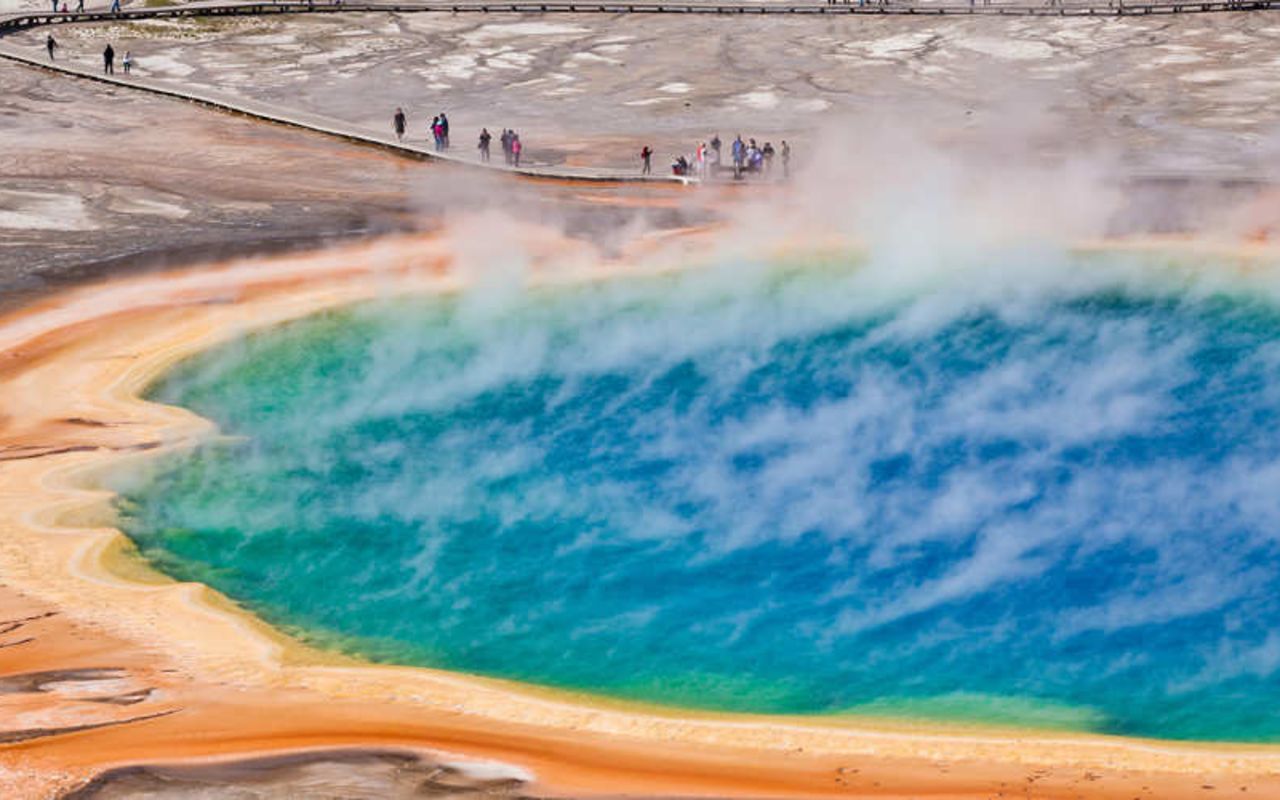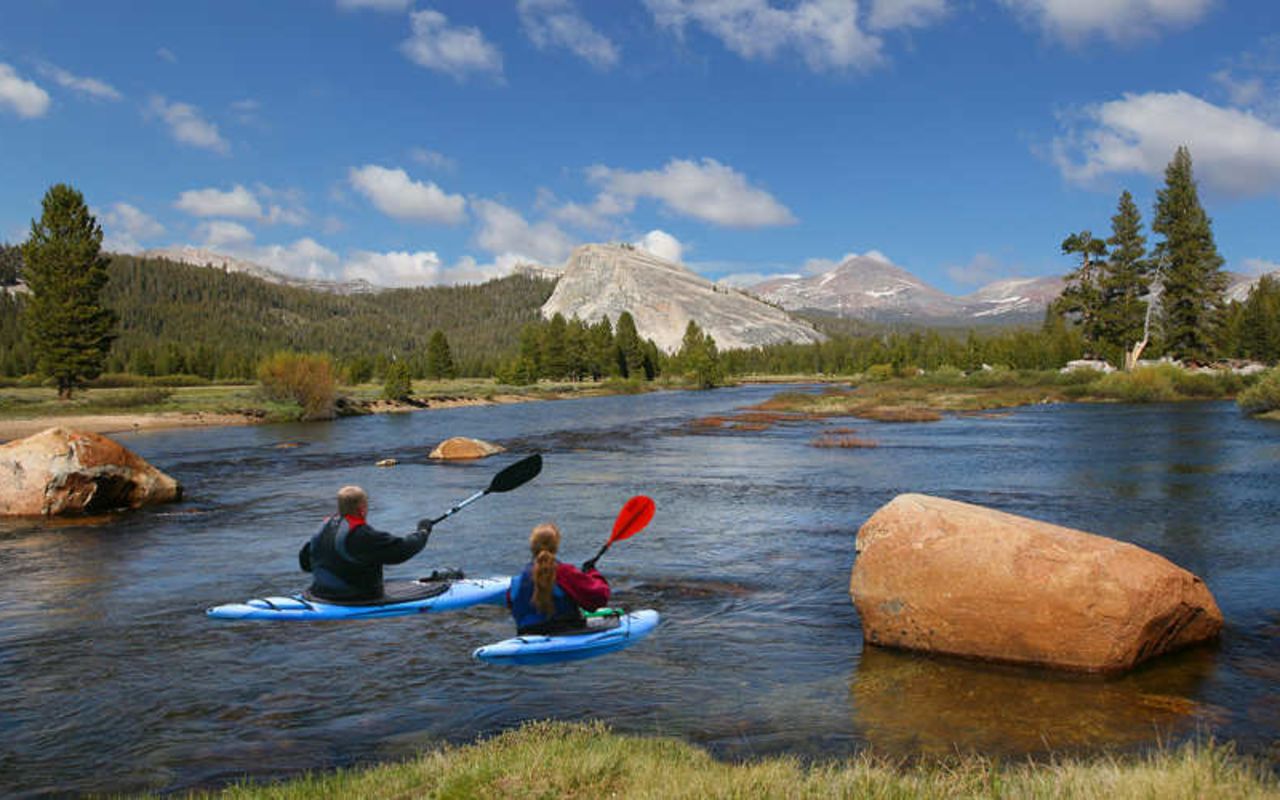Yellowstone National Park
Yellowstone is America's first national park, established in 1872--though people have been exploring its beauty for over 11,000 years.
Yellowstone Geysers & Hot Springs
In Yellowstone National Park there are about 500 geysers and some 10,000 thermal features. Yellowstone contains the majority of the world's known geysers. The geysers and other features are major attractions. Old Faithful geyser is perhaps the park's best know and most visited attraction.
Many lesser-known geysers are equally impressive and can be seen along park roads or at the end of short hikes. Others are located far into the backcountry where they are difficult to reach.
Why are there so many thermal features here? Much of Yellowstone sits inside an ancient volcanic caldera (the exploded crater of a volcano). The last major eruption occurred about 600,000 years ago. For hundreds of thousands of years after that eruption, subsequent lava flows slowly filled in most of the caldera. Even now, in some places, nearly molten rock resides as little as 2-5 miles below the surface. Water percolates down into the caldera and is heated by that volcanic activity. The heated water and steam develops great pressure, forcing it to the surface and producing the park's geysers, hot springs, fumaroles and mudpots.
Many of these thermal features are located in Yellowstone's major geyser basins: Upper, Midway, Lower, Norris, West Thumb, Shoshone and Heart Lake.
Yellowstone Lake
Yellowstone Lake is the largest lake in Yellowstone National Park. It covers about 136 square miles and has an average depth of about 139 feet, with its deepest spot dropping down 390 feet.
The lake is a very popular area to camp, boat, fish and hike.
Yellowstone Lake is located near the center of Yellowstone Park, about 22 miles north of the South Entrance. Roads follow the lake's west and north shorelines, providing easy access. Trails run along the lake's eastern shoreline and provide access to some points on that shoreline.
The famous Fishing Bridge is located on the Yellowstone River near where it comes out of Yellowstone Lake. From the bridge, you can often see large cutthroat trout swimming in the clear water. The cutthroat trout are native to the lake and river, and the waters are managed for their benefit. Fishing is allowed. Check the park website or at a visitor center for the latest information on license requirements and regulations.
A Yellowstone boating permit is required to operate a boat of any kind on the lake. Boats are defined as pretty much anything at floats, from motorboats to canoes, kayaks and float tubes. In some areas, boats are restricted to slow speeds; in other areas only boats without motors are permitted. Launch ramps are located in 3 spots on the lake. The marina at Bridge Bay offers boat rentals.
A geothermal area exists in the lake's West Thumb region. It includes hot springs, geysers and fumaroles. Some come up under the lake, others can be seen nearby.
Grand Canyon of the Yellowstone
The Grand Canyon of the Yellowstone is a deep, impressive canyon cut by the Yellowstone River in Yellowstone National Park. Thundering waterfalls and colorful canyon walls make the area very photogenic.
It's located near Canyon Village, just north of Yellowstone Lake, near one of the park's main road junctions. Many scenic viewpoints can be reach by short hikes from paved roads in this area. Trails run along the rims of the canyon and also down into the gorge, to a variety of scenic viewpoints.
One of the iconic images of the park is the view from Artists Point up the Grand Canyon of the Yellowstone to Lower Falls.
At Lower Falls, the entire Yellowstone River drops some 308 vertical feet. It is the largest and perhaps the most spectacular waterfall in the park. By volume, it is the largest waterfall in the Rocky Mountains. It is one of the must-see attractions in the park.
The Yellowstone River flows north out of Yellowstone Lake, through the Hayden Valley. It drops over Upper Yellowstone Falls (109 feet) and then flows about a quarter-mile before plunging over the Lower Falls.
Crystal Falls drops into the gorge between the upper and lower waterfalls. It is also photogenic and worth seeing.
Yellowstone's lush conifer forest comes out along the canyon rims. The canyon itself is up to 900 feet deep and up to a half mile wide. It is an impressive sight.
An interpretive brochure about the canyon can be picked up at one of the park visitors centers.
Wildlife
Yellowstone Park is one of the worlds great places to observe and photograph wild animals. The diversity of wildlife in the park is astounding, and the sheer number of animals is also very impressive. It is an area where animals can live and run free, in a natural environment, managed to preserve wildness and natural conditions.
Much is said about the danger posed by bears and bison. These animals are large and easy to see, especially when they are encountered along roadways. They sometimes appear to be relatively tame and not threatening, but that is an illusion. Both animals are fast, powerful and unpredictable.
Small animals may also appear to be friendly and not threatening. That is also an illusion. Even chipmunks and bunny rabbits can cause painful injuries. They are wild and they will kick, scratch, claw and bite if you attempt to touch them.
Below are some basic rules to help you stay safe around wildlife:
- Never approach animals in the wild (use telephoto lenses for closeup photos).
- Never feed animals.
- Pay attention not to walk between a mother animal and her babies.
- If you camp, learn safe camping techniques.
- If you hike in the backcountry, learn safety techniques.
Yellowstone | Photo Gallery


Yellowstone National Park
Location
Get DirectionsWeather
Articles
View AllFall/Winter Family Itinerary: 6 Days Logan to Jackson to Yellowstone
Enjoy a winter getaway between Logan, Jackson Hole, and Yellowstone National Park. Enjoy skiing, hik...
7 Must-Do Backpacking Trails in Northern Utah
Find the best backpacking trails and camping areas in Northern Utah. Compare hikes and plan your nex...
Top 5 Mountain Biking Trails in Northern Utah
Northern Utah has some of the most stunning mountain biking trails in the state. Find the best bikin...
7 Places to Stand-Up Paddleboard (SUP) in Northern Utah
Utah's lakes and reservoirs offers amazing paddle boarding locations. Find the seven best places to ...
